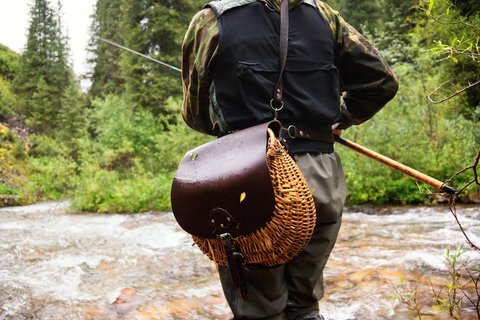Few people would confuse fly anglers with big game hunters, but both activities require a significant amount of tact and stealth to achieve their ultimate objective.
While much of the information available on fly fishing for trout revolves around fly selection and casting techniques, one of the most important factors in how many fish you catch lies in your approach to the stream and the trout, not in what type or size of fly you have on the end of your line.
RELATED: 4 Fly Fishing Essentials You Can’t Leave Behind
Fishing magazines and calendars often show photos of fly anglers standing upright in the middle of a stream, wearing brightly colored clothing. Unfortunately, this is done not as an example, but for dramatic effect.
In reality, you want to do everything you can to stay out of a trout’s field of vision. Trout are continually watching for danger from above, such as herons, egrets, osprey and other predators. So any unusual movement from an angler can send them bolting for cover. If your movements scare the trout, you have erased any hope for success.
RELATED: Top 10 Trout Flies
One of the best ways to avoid scaring trout begins at home. The clothing you choose to wear can make all the difference in your success. Just as hunters wear camouflage clothing, fly anglers should wear clothing that blends into the surroundings and helps keep them hidden. Browns, tans and greens are the best choices. Avoid anything brightly colored or unnatural in appearance.
Another way to stay out of sight is to keep a low profile. Some fly anglers will go as far as crawling up to a promising pool to avoid detection. At the very least you should stay crouched down as low to the ground as you can. Use the landscape to hide your profile. When possible, make casts from a kneeling position or from behind a tree or high grass.
RELATED: Fly Tactics for Early Spring Trout
You can also avoid detection from trout by doing everything you can to stay out of the water. Nothing alerts a trout to your presence more quickly than tromping through the water splashing and raising clouds of mud from the bottom. Try to stay hidden on the bank. If you must enter the stream, walk in rocky riffles where the sound of the gurgling water can help mask your movements and the rocky bottom is less likely to raise clouds of mud that will alert the fish to your presence.
Additionally, you can reduce the odds of spooking trout by the direction you approach them on a stream. Ideally, you want to be moving upstream. Trout are almost always facing upstream waiting for food to drift toward them. By approaching them from behind they are less likely to spot you. If you are working your way downstream, walk away from the stream, well out of the trout’s vision; then circle back to promising areas and approach each location from behind the trout.
Lastly, in addition to keeping your body out of sight, you also want to reduce the impact your line has in spooking the fish. The best way to do this is to begin casting to the water closest to you and gradually working your way outward. If you begin by casting across the water to the opposite bank, your line landing on the water will likely scare every fish between you and the other bank, which will significantly reduce your odds of success.
© Maxim Petrichuk | Dreamstime.com – Fly-fishing








